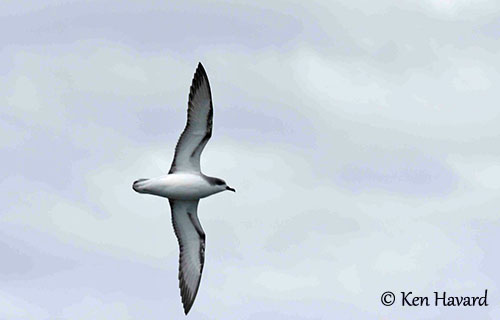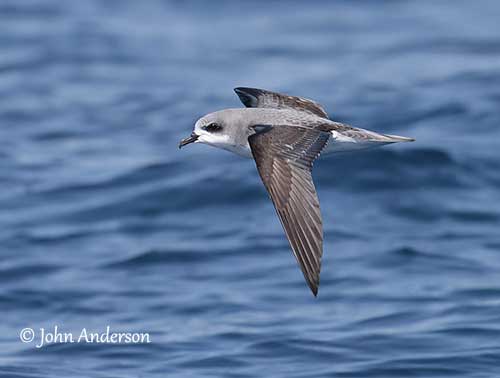
Cook’s Petrel
Pterodroma cookii
Procellariiformes Order – Procellariidae Family
INTRODUCTION:
The Cook’s Petrel is endemic to New Zealand where it breeds on adjacent islands. After breeding, it migrates to E Pacific and can be seen well off the west coasts of the Americas.
Like numerous birds living on islands, the Cook’s Petrel has suffered rapid declines due to the introduced predators. But today, thanks to conservation measures and eradication of introduced invasive species from some parts of the breeding range, the numbers are slowly increasing.
DESCRIPTION OF THE BIRD:
Biometrics:
Length: 25-30 cm
Wingspan: 65-66 cm
Weight: 180 g
The adult is a medium-sized bird with grey-and-white plumage and narrow wings. The grey upperparts contrast with a conspicuous black-brown M across upperwing and rump. The tail is grey with dark central rectrices having darkest tips, whereas the outer tail feathers are paler grey with white on outermost pairs.
The underparts are mostly white, except a dark patchy line forming a leading edge on the outer part of the underwing.
The head is grey, speckled white-and-dark on crown and forehead. We can see a short, white supercilium, and a dark area below the eye.
The black bill is 25-30 millimetres long. The eyes are dark brown. The legs are dull bluish-grey or dull pinkish flesh. The webbed feet are yellowish with black margins.
REPRODUCTION OF THIS SPECIES:
The breeding season of the northern population occurs between September and April, but the southern birds breed one month later.
The Cook’s Petrel nests in a long burrow running sometimes between tree roots on a slope. The nest-chamber is well-lined.
The female lays a single white egg in November. The incubation lasts about 47 days, shared by both adults. It is divided into three stints of 12-16 days, often starting with the male.
At hatching, the chick is covered with pale grey down above, and mostly whitish below. It is fed by its parents and becomes independent at fledging in March, at about 3 months old.
If it is threatened, it ejects oil onto the fur or the feathers of the predator, making them less waterproof or vulnerable to insulation.
PROTECTION / THREATS / STATUS:
The Cook’s Petrel is threatened by cats and rats at breeding colonies, and by the introduced Weka on Codfish Island.
Today, after eradication of cats and rats from Little Barrier Island and of Weka from Codfish, the fledging success has increased. Translocation of chicks to new potential sites is on-going, and in 2012, 250 chicks had been moved over three years.
The global population is estimated at about 670,000 mature individuals. After rapid declines due to introduced predators, the population is suggested now to be increasing, following conservation action.
However, the Cook’s Petrel is currently listed as Vulnerable.
Fr: Pétrel de Cook
Maori: Titi
Ang: Cook’s Petrel
All: Cooksturmvogel
Esp: Petrel de Cook
Ita: Petrello di Cook
Nd: Cooks Stormvogel
Sd: Cooks petrell
Photographers:
John Anderson
John Anderson Photo Galleries
Ken Havard
My Bird Gallery & Flickr gallery 1 & Flickr gallery 2
Text by Nicole Bouglouan
Sources:
HANDBOOK OF THE BIRDS OF THE WORLD vol 1 by Josep del Hoyo-Andrew Elliot-Jordi Sargatal - Lynx Edicions - ISBN: 8487334105
BirdLife International (BirdLife International)
New Zealand birds and birding (Narena Olliver)
New Zealand bird status between 2008 and 2012
What Bird-The ultimate Bird Guide (Mitchell Waite)
Page family Procellariidae
Summary cards

Both sexes are similar, but the male is usually slightly larger than the female.
The juvenile shows paler feather tips on the upperparts, contrasting with the darker wings and tail.
RANGE:
The Cook’s Petrel is confined to three islands in New Zealand. The largest colony occurs on Little Barrier Island, and there are few birds on Great Barrier Island, both in the North. But this species also breeds in the South on Codfish Island, off Stewart Island coast.
After breeding, it migrates to E Pacific and occurs off the west coasts of the Americas.
HABITAT:
The Cook’s Petrel usually nests under tall trees in forest, often above 200 metres of elevation, but also in patches of mature vegetation at lower altitude.
The nesting burrow is often among the roots or below a fallen tree, or under rocks, in soft soil.
The Cook’s Petrel is highly pelagic and comes to land only for breeding. It may cover very long distances during its foraging trips at sea.
CALLS AND SONGS: SOUNDS BY XENO-CANTO
The Cook’s Petrel gives bleating sounds “kek-kek-kek” or nasal calls “nga-nga-nga” sometimes given in long sequences and in flight. We can also hear lower pitched “boor” or a loud purring. It is probably silent at sea.
BEHAVIOUR IN THE WILD:
The Cook’s Petrel feeds typically on small squid complemented with fish and crustaceans. It feeds at night, but during the breeding season, it may forage by day too.
It forages at water surface at sea, but it is able to dive down at least to 20 metres. It usually feeds mainly by surface-seizing, and catches the preys with the bill from the sea surface.
The Cook’s Petrel has its tubular nostrils on the sides of the bill, giving it an acute sense of smell, very helpful while foraging in the darkness.
Like other petrels, it is active at night at breeding colonies. They are very vocal as the birds leave the breeding island after dark for foraging. However, they rarely call on the ground.
After the first visit to the nesting burrow, they go to sea during 25-27 days prior to laying and incubation.
The pairs are monogamous with long-term pair-bonds lasting several following seasons.
The Cook’s Petrel migrates to E Pacific between April and November, after the breeding season. It can be seen N from the Aleutian Islands and Hawaii, and E to California and west coasts of South America, to S Peru.
It has rapid and erratic flight with fast jerky wingbeats. It performs much weaving and banking, interspersed with high soaring arks.
